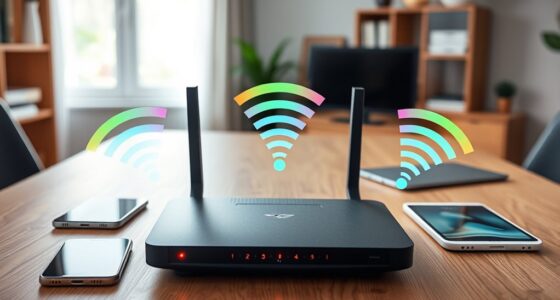To create home-automation scenes that work, start by customizing voice commands with simple, natural phrases for easy activation. Schedule scenes to trigger at specific times for routines like mornings or bedtimes, and align these with your daily habits. Focus on personalization to make your home respond intuitively, and guarantee device compatibility for smooth operation. By combining tailored commands with smart scheduling, you’ll enhance comfort, security, and energy efficiency—continue exploring to master these powerful automation strategies.
Key Takeaways
- Define specific, personalized scenes for different routines like waking, leaving, or bedtime.
- Use simple, natural voice commands and multiple phrases for reliable scene activation.
- Schedule scenes to activate automatically at set times, aligning with daily habits.
- Integrate customized commands with schedules to automate key moments seamlessly.
- Test and refine scene setups to ensure smooth operation and enhance home responsiveness.

Home-automation scenes allow you to seamlessly control multiple devices with a single command or preset. These scenes streamline your daily routines, making your home smarter and more responsive. To make the most of this feature, you should focus on customizing voice commands and scheduling scenes effectively. Voice command customization lets you tailor how you activate scenes, ensuring that commands are intuitive and easy to remember. Instead of complex phrases, you can set simple, natural language instructions that trigger your desired scene. For example, saying “Good night” could turn off all lights, lock doors, and adjust the thermostat. This personalization makes controlling your home feel effortless and natural, reducing the need to remember specific device names or complex sequences. Incorporating home-automation system compatibility can further enhance your scene effectiveness and integration.
Customize voice commands for effortless, natural control of your smart home scenes.
Scene scheduling is equally important for creating a truly automated environment. By setting specific times for scenes to activate, you ensure your home responds proactively to your routines. For instance, you might schedule a morning scene that gradually turns on lights, opens blinds, and starts your coffee maker at your usual wake-up time. In the evening, a different scene could dim the lights, turn on soft music, and set the temperature to a cozy level just before bedtime. With scene scheduling, your home adapts to your daily patterns, eliminating manual adjustments and enhancing convenience. It also helps conserve energy by ensuring devices are only active when needed, contributing to a more efficient household.
When designing your scenes, think about how voice command customization can align with your routines. Use familiar phrases that make sense to you, and test different commands to find what feels most natural. Consider creating multiple voice commands for the same scene, so you can activate it in various ways depending on the situation. Combining this with scene scheduling allows you to automate key moments, like waking up, leaving the house, or going to bed, with minimal effort. You’ll appreciate waking up to a well-lit, warm home, or leaving for work to find everything turned off and secured, all set by scheduled scenes.
Ultimately, creating home-automation scenes that work revolves around personalization. By customizing voice commands and scheduling scenes thoughtfully, you turn your smart home into a truly responsive environment. This approach not only simplifies your daily routines but also enhances comfort, security, and energy efficiency. With a little planning, you can craft scenes that automatically adjust to your lifestyle, making your home more intuitive and effortless to manage.
Frequently Asked Questions
How Do I Troubleshoot Scene Automation Failures?
To troubleshoot scene automation failures, start with scene debugging by reviewing your automation logs for errors or unusual activity. Check if the devices involved responded correctly and make sure all triggers and conditions are correctly set. If issues persist, disable and re-enable the scene, update firmware, or restart your hub. Regularly monitoring logs helps you identify the root cause quickly, ensuring your scenes work smoothly every time.
Can I Customize Scenes for Multiple Users?
Yes, you can customize scenes for multiple users by tailoring preferences and personalized controls. You’ll want to set up individual profiles within your smart home system, allowing each person to modify settings to their liking. By assigning specific scenes to users, you ensure a seamless, personalized experience. This approach promotes perfect personalization, providing peace of mind and practical convenience, all while pleasing every person’s preferences with precise, personalized controls.
What Security Measures Protect My Automation Setup?
You protect your automation setup by using secure protocols like WPA3 for Wi-Fi and TLS for data exchange. Guarantee all devices have strong, unique passwords, and enable device encryption whenever available. Regularly update firmware to fix vulnerabilities, and consider setting up a separate network for your smart devices. These steps help keep your automation system safe from unauthorized access and cyber threats.
How Do I Update Scenes After Initial Creation?
To update scenes after initial creation, start with scene editing in your home automation app. You can easily modify device settings, timing, or triggers to reflect your changing needs. After making these automation updates, save your changes, and your scene will run with the new parameters. Regular scene editing guarantees your automation stays current, efficient, and tailored to your lifestyle, without needing to recreate scenes from scratch.
Are There Energy-Saving Benefits to Scene Automation?
Did you know that properly programmed scenes can reduce energy consumption by up to 30%? Yes, scene automation offers significant energy efficiency and cost savings by turning off lights, adjusting thermostats, and managing appliances when not needed. This smart control minimizes waste, lowers utility bills, and helps the environment. By optimizing your home’s automation scenes, you get more savings and a greener lifestyle without sacrificing comfort or convenience.
Conclusion
By creating tailored home-automation scenes, you can effortlessly enhance your daily life and save energy. Did you know that smart home devices can reduce household energy consumption by up to 30%? That means not only making your home more convenient but also more eco-friendly. Start experimenting with scenes today, and you’ll enjoy a smarter, more efficient living space that adapts perfectly to your routines. Embrace automation and transform your home into a truly intelligent environment.









